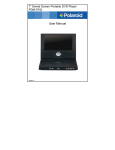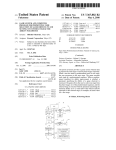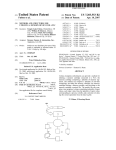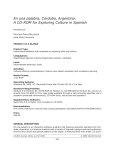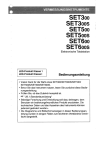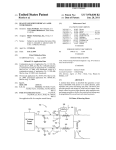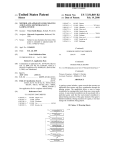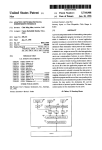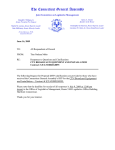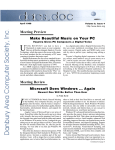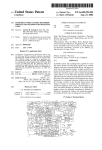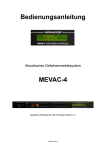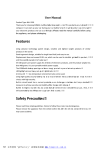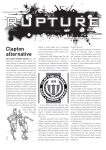Download System, method, and computer program product for selective
Transcript
US008245252B2
(12) United States Patent
(10) Patent No.:
Gee et a1.
(45) Date of Patent:
(54) SYSTEM, METHOD, AND COMPUTER
Aug. 14, 2012
ggggjggélgggg i}: Z588; $11.“. ~~~~~~~ "i ~~~~~~~~~~~~~~~~~ "735/5432
2007/0201694 A1 *
PROGRAM CONTENT WITH
(75)
US 8,245,252 B2
8/2007
Bolle
apissier
et a1.
et ..................
a .
.. 380/205
OTHER PUBLICATIONS
LESS'OBJECTIONABLE CONTENT
Kenneth M. Chanko, “No-Fuss No-Cuss Movie Cleanup”, Entertain
ment Weekly, #453, Oct. 9, 1998.
IIIVBIIIOI‘SZ Jeanette Gee, Chattanooga, TN (Us);
Gary Robson, Belfry, MT (US); James
])_ Gee, Jr" Chattanooga’ TN (Us)
Harry Somer?eld, ‘“V-Chip’ for TV Will Filter Language Un?t for
Children”, San Francisco, CA, Chronicle, Dec. 2, 1998, San Fran
cisco-Oakland-San Jose Metropolitan Area, CA, USA.
(73) Assignee: Caption TV, Inc. (CA)
( * ) Notice:
(Commued)
Subject to any disclaimer, the term of this
Zrlmary jigamwer i PCaEka1]
patent is extended or adjusted under 35
“Islam xammeri
U_S_C_ 154(b) by 1462 days'
_
_
_
vided for the selective replacement of objectionable content
Pnor Pubhcatlon Data
Us 2004/0049780 A1
_
(57)
ABSTRACT
A system, method, and computer program product is pro
seP- 9: 2003
(65)
k
10 S
Attorney, Agent, or Fzrm * Katten Muchrn Rosenman
(21) Appl.N0.: 10/658,344
(22) Filed?
es
in a program With less-objectionable material. The selective
Man 11, 2004
replacement of objectionable content‘ in a program With less
objectlonable material 1s accompllshed by apply1ng an
Related US, Application Data
(60)
P
_ _
1
1,
t,
rovlslona app 102‘ Ion
N
encoding process and a decoding process to the audio and/or
60/409 270 ?l d
0'
’
’
S
e on
video signal of the program. The encoding process includes
ep'
10’ 2002'
(51) I t Cl
With replacement information that identi?es the type (e.g.,
audio, violent content, sexual content, etc.) and intensity level
5102M, H0
(2006 01)
(e.g., mild, graphic, extreme, etc.) of the potentially objec
H04N 7/025
(2006'01)
tionable material using replacement codes. The decoding pro
'
_
_
cess includes comparing, during the presentation of the pro
(52)
US. Cl. ...... .... ...... ... ............ .. 725/36, 725/20, 725/28
(58)
Field of Classi?cation Search .................. .. 725 20,
_
(56)
marking potentially objectionable material in the program
_
_ 725/28’ 36
See apphcanon ?le for Complete Search hlstoryRe ferences Ct
d
1 e
3/1997
Abecassis
IWamura ..
6,519,770 B2*
Ford ....... ..
725/28
1/2004 Block et al.
725/28
6,675,384 B1 *
7,370,343 B1*
2002/0108111 A1*
5/2008
8/2002
ment settings, to determine Whether replacement of the poten
tially objectionable content (i.e., audio and/or video) should
be performed. If replacement is to be performed, the objec
replacement information Which, in the preferred embodi
................... .. 348/170
6,501,515 B1* 12/2002
2/2003
displaying the Video’ the replacement information to a
replacement criterion, Which includes user supplied replace
tionable content in the program is replaced according to the
U.S. PATENT DOCUMENTS
5,610,653 A *
gram to the user and prior to outputting the audio or
..
348/734
ment, identi?es the start and duration of the replacement and,
for replacement of the video of the program, also identi?es
the display area of the video to be replaced.
Ellis ............... ..
725/58
CeZeaux et al. .............. .. 725/39
31 Claims, 5 Drawing Sheets
luenmy
Area at
DlsDlay
lnfolmalion
US 8,245,252 B2
Page 2
OTHER PUBLICATIONS
Robert Moritz, Dirty-Word Cop, The Gadget Guide Tools for High
Tech Living, Parade magazine.
Elizabeth Shaw, “New device kicks foul language in the @$ ! #”, Flint,
MI Journal, Nov. 22, 1998, Flint, MI, USA.
“Gadget will ?lter the unpredictable words out of your television
programs”, St. Louis, MO Post-Dispatch, Dec. 7, 1990, St. Louis,
MO, USA.
North Little Rock, AK Times, Nov. 26, 1998, pp. 31-32, Little Rock,
AK, USA.
Martha Mendoza, “New Electric Gadgets Debut at Show”,
washingtonpostcom, Jan. 8, 1999.
“TVGuardian (Principle Solutions)”, Computing Today, Feb. 1999,
Carol Stream, IL, USA.
Mike Snider, “Big ticket is the hot ticket at electronics show”, USA
Today, Jan. 11, 1999, p. 6D, USA.
User’s Manual, TVGuardian, The Foul Language Filter, pp. 1-8, ©
2000 Principle Solutions Inc., Rogers, AR, USA.
Evan Ramstad, “TV Guardian Screens the Tube and Filters Out Foul
Language”, The Wall Street Journal, Technology Journal, Under the
Radar, Feb. 18, 1999, p. B6, USA.
Brendan O’Reilly, “Parents buying TV censor boX to axe bad words”,
“How the XXXX did this little boX win two awards? And what the XXXX
is TVGuardian anyway?”, Advertisement, TV Guardian, The Foul
Language Filter, Principle Solutions, patent pending.
“We don’t mind hearing these four-letter words. Best of Show”,
Advertisement, TV Guardian, The Foul Language Filter.
“People swear by TVGuardian. They just can’t swear through it”,
Advertisement, TV Guardian, The Foul Language Filter, Principle
Solutions, patent pending.
* cited by examiner
US. Patent
Aug. 14, 2012
(
Sheet 1 of5
Start
US 8,245,252 B2
)
110
‘V
Encode
Content
Ext’ract
120
Replacemen/
information
V
Compare
130
Replacemem/
Information
withRaplaceJnent
Criteria
I
140
Perform /
Replacemen
150
7
Output /
Replaced
Content
FIG. 1
US. Patent
Aug. 14, 2012
Sheet 2 of5
i
Start
US 8,245,252 B2
i
V
2 0
identify
210
‘ Potentially /
# Objeotionai
Material
V
Identify
220
Start and /
Stop of
Material
240
260
\
230
Yes
IS
/
NO
.
Area of
Material Video
ma/engfy
Display
or Audio?
or
V
250
‘281cm:
/
n ens‘ y
270
280
Define
> Replaoemeri
Information
ADPY'1 l/290
Repiaoemen
information
FIG. 2
'
\ Channel
Identify
US. Patent
Aug. 14, 2012
Sheet 3 of5
I
Start
US 8,245,252 B2
I
‘
Decode
Closed
Caption
/
300
F
2
Identify /3 O
Repgcgment
0J3
l
|
|
|
l
l
l
l
I
:
I
I
I
I
I
I
I
L.
430
I
I
I
l
l
l
I
I
330
ls Code a
Video Code?
340
ls Code
Type Being
eplaced?
35g
Intensity
Level Being
Replaced?
400
360
:
and Stop
of Replacerr ent
370
Identify Area
To Be
Identify Start
7
Replaced
_
I
Identify Start
~
_
_
and Stop
of Replacement
_
_
*
_
_
M
_
v
_
_
_
_
_
h
420
‘
FIG. 3
38O\ R I
e532;
\
Output
* Replaced v
Signal
_
__
__
_
*
__
_
I
I
I
I
I
I
I
I
US. Patent
Aug. 14, 2012
Sheet 4 of5
US 8,245,252 B2
mom
mzumg
ZmowEnSfb.QAIwloYi
owm
6l98m
0%0m:55
>m5w @QS Q
@853m25
0mm
m vwé
onm
lam0mm
8omE> .|50Ym 0mm
@2‘I50 0mm
.01w
US. Patent
Aug. 14, 2012
Sheet 5 of5
US 8,245,252 B2
oHw3nOs
_
_
“6 89.5 6_.6
uco_w
_
~
_
m2:360
_BoEmE_ovw
boEm omw
Emwo . @250
2%
A
mEwo m
0A62r4
8cosumbxw 3m 0@@
O
(D
mi
US 8,245,252 B2
1
2
SYSTEM, METHOD, AND COMPUTER
ing system, that use a “V-chip” approach, or that use a pro
PROGRAM PRODUCT FOR SELECTIVE
REPLACEMENT OF OBJEC TIONABLE
PROGRAM CONTENT WITH
LESS-OBJECTIONABLE CONTENT
prietary rating system. See, for example, US. Pat. No. 5,485,
518 to Hunter et al. Such systems are effective for ?ltering
audio and/or video content that the user or vieWer indicates
should be blocked based on such content being associated
With a speci?c rating. The speci?c ratings, hoWever, are
applied to an entire program and, as such, the systems that
block audio and/or video content based on such ratings block
or alloW through the entire program.
These systems are “go or no-go” systems, as discussed
CROSS REFERENCE TO RELATED
APPLICATIONS
This Application claims the bene?t of US. Provisional
above. Either the entire program is deemed appropriate and
let through, or inappropriate and blocked depending on the
rating. There is no capability in such systems for alloWing the
Application No. 60/409,270 ?led Sep. 10, 2002.
COPYRIGHT NOTIFICATION
user or vieWer to Watch the program, but to replace objection
Portions of this patent application contain materials that
are subject to copyright protection. The copyright oWner has
no objection to the facsimile reproduction by anyone of the
able material (audio or video) With less-objectionable mate
rial, such as, eg advertisements.
Furthermore, many of the various prior art systems that
patent document, or the patent disclosure, as it appears in the
Patent and Trademark Of?ce.
provide for ?ltering of audio and/or video content require
specialiZed hardWare or additional components to perform
20
BACKGROUND OF THE INVENTION
1. Field of the Invention
The present invention relates, generally, to the ?eld of
processing of audio and/ or video signals, such as for example
television broadcasts, movies, and other programs, and, more
particularly, to a system, method and computer program for
selective replacement of objectionable content in a program
With less-obj ectionable content, such as, eg advertisements.
2. Description of the Related Art
25
the replacement function, such as audio-video devices that
use dedicated circuitry, components, or chip sets. See, e.g.,
US. Pat. No. 5,828,402 to Collings; US. Pat. No. 4,554,584
to Elam; and US. Pat. No. 5,387,942 to Lemelson. While
these systems are able to block content deemed to be objec
tionable by the vieWer or user, the implementation of the
?ltering function is dependent on inclusion of the required
hardWare into the audio-video device. Such necessary hard
Ware increases the cost of such equipment, makes upgrading
or updating to improve functionality and/ or to add features
30
It is a common desire of many vieWers or listeners of
dif?cult and, in most cases, impossible, and severely limits
Widespread adoption and use.
US. Pat. No. 6,230,320 to Gakumura discloses a system
television, movies, music, and other programs to ?lter por
and method for temporarily releasing vieWing restrictions in
tions of the audio and/or video of such programs. For
example, many parents prohibit their children from Watching
a television receiver employing a V-chip system. In order for
cable television broadcasts, certain movies, or other programs
because the audio of the program may include inappropriate
language or the video may include inappropriate content,
such as nudity, sexual content, or violence, that is unsuitable
for children. In addition, since the parent has not seen the
program, the parent may not knoW Whether the content of the
program is inappropriate for the children or not. Conse
35 the user to vieW the blocked program, the user must enter a
vieWing restriction release command to temporarily release
vieWing restriction based on the contents of a rating set. This
entry results in the vieWing restriction based on the contents
of the set rating being invalid With the contents of the set
40
entered. The program can be reblocked by the user entering a
quently, parents may inadvertently permit their children to
vieW a program not knoWing portions of it are inappropriate,
or conversely, may prohibit vieWing of the program even
though its content does not include any inappropriate por
tions.
In an effort to solve this dilemma, the US. Federal Com
rating held When the vieWing restriction release command is
45
vieWing restriction return command to return the vieWing
restriction, Which makes the vieWing restriction based on the
contents of the set rating valid. While this system provides a
temporary Way to unblock a previously blocked program, it
does not provide the capability of alloWing the user or vieWer
to Watch a program, While replacing objectionable material
munications Commission (“FCC”) has established provi
(audio or video) With less-objectionable material, such as,
sions (EIA-608-B) for attaching parental guidelines (“rat
eg advertisements.
ings”) to broadcasts using any of four different systems (US.
TV, U.S. MPAA, Canadian English, and Canadian French).
According to the FCC guidelines, hoWever, only one rating
may be applied to any given program and that rating may not
50
change during the course of the program.
The inability to change the rating midWay during the
55
broadcast makes the FCC parental guideline system a “go or
no-go” system. In other Words, either the entire program is
deemed appropriate or inappropriate depending on the rating.
it is not displayed on the television screen. Based on detection
The system estimates the time at Which it should start
60
broadcast or program, it does not facilitate ?ltering of por
tions of the program to prevent vieWers (e. g., children) from
seeing or hearing particular portions of the program that are
based on or rely on the use of a government or industry-Wide
program rating system, such as the previously discussed rat
muting the audio and the length of the timed period. The
disclosure indicates that the period of time for Which the
audio signal is turned off is ?exible. A longer period during
Which the signal is turned off tends to decrease the chance of
objectionable.
There are various prior art systems and methods that are
the Words in the transmitted closed caption With a list of
offensive Words. When an offensive Word is detected, the
system Will remove it from the closed caption stream so that
of the offensive Word in the closed caption stream, the system
mutes (i.e., turns off) the audio signal for a timed period.
Consequently, While the rating system is helpful to parents in
determining Whether to permit the child to vieW the entire
US. Pat. No. 6,075,550 to Lapierre, Which is hereby incor
porated by reference, discloses a system that ?lters the closed
caption and/or audio of a television program by comparing
objectionable material getting through; hoWever, this also
65
tends to ?lter a greater amount of unobjectionable material. A
shorter period during Which the signal is turned off tends to
have the opposite effect.
US 8,245,252 B2
4
3
The period of time for Which the audio signal is turned off
replacement of the audio and/ or video signal With less-objec
tionable material, such as, eg advertisements.
Yet another key object of the present invention is to provide
a system, method, and computer program product that can
identify speci?c portions of the audio and/or video content of
a program as objectionable for selective and precise replace
ment of the audio and/or video signal With less-objectionable
material, such as, eg advertisements.
Another key object of the present invention is to provide a
system, method, and computer program product that can
ensure that only the objectionable content is replaced, and
that substantially all non-objectionable content is not
replaced and substantially all objectionable content is
replaced With less-obj ectionable material, such as, e. g. adver
may also be a function of the Word or phrase encountered.
Where a particularly objectionable Word, or particular
lengthy objectionable phrase is encountered, the audio signal
may be turned off for a relatively long period of time.
Similarly, Where the Word is less objectionable and does
not involve a lengthy phrase, the audio signal may be turned
off for a relatively short period of time. Thus, the system
estimates When in the audio signal the Word is likely to appear,
based on the arrival of the Word in the closed caption stream,
to determine When, and for hoW long, to mute the audio.
While the system is effective in ?ltering offensive Words from
the closed caption stream, ?ltering of the audio signal is based
on an estimate and may result in audio that is not objection
tisements.
able being blocked or audio that is objectionable getting
through. Plus, the system does not provide the capability of
Still another key object of the present invention is to pro
vide a system, method, and computer program product that
can replace both audio and video content that is objectionable
With less-obj ectionable material, such as, eg advertise
replacing objectionable material With less-obj ectionable
material, such as, eg advertisements.
Further, the system does not address objectionable content
that may be present in the video signal. See also US. Pat. No.
20 ments.
Yet another key object of the present invention is to provide
6,166,780 to Bray.
Thus, notWithstanding the various systems and methods of
a system, method, and computer program product that can
mark, identify, and replace objectionable content based on
different types and levels of intensity of objectionable mate
the prior art, there is a need for a system, method, and com
puter program product that provides for the selective replace
25
rial.
Another key object of the present invention is to provide a
system, method, and computer program product that can be
implemented in a variety of audio-video devices Without
requiring any specialiZed hardWare or additional compo
ment of objectionable material (audio or video) With less
objectionable material, such as, eg advertisements. Further,
there is a need for a system, method, and computer program
product that provides such selective replacement of objec
tionable content: (1) that can alloW the user or vieWer to Watch 30 nents.
The present invention achieves these objects and others by
providing a system, method, and computer program product
for the selective replacement of objectionable material (audio
a program, While replacing objectionable material (audio or
video) With less-objectionable material, such as, eg adver
tisements; (2) that can mark speci?c portions of the audio
or video) With less-obj ectionable material, such as, e. g. adver
and/ or video content of a program as objectionable for selec
tive and precise replacement of the audio and/or video signal;
(3) that can identify speci?c portions of the audio and/or
35
tisements. The selective replacement objectionable content in
a program is accomplished by applying an encoding process
video content of a program as objectionable for selective and
and a decoding process to the audio and/or video signal of the
precise replacement of the audio and/ or video signal; (4) that
program. The encoding process includes marking potentially
objectionable material in the program With replacement
can ensure that only the objectionable content is replaced
With less-objectionable material, such as, eg advertise
ments, and that all non-obj ectionable content is not replaced
and all objectionable content is replaced; (5) that can replace
both audio and video content that is objectionable With less
objectionable material, such as, eg advertisements; (6) that
can mark, identify, and replace objectionable content based
40
45
on different types and levels of intensity of objectionable
material; and (7) that can be implemented in a variety of
audio-video devices Without requiring any specialiZed hard
50
SUMMARY OF THE INVENTION
55
With less-objectionable material, such as, eg advertise
ments.
video of the program, also identi?es the display area of the
video to be replaced.
In a preferred embodiment of the present invention, the
program is encoded With replacement information in the form
of replacement codes that mark content that is potentially
60
alloW the user or vieWer to Watch a program, While replacing
objectionable material (audio or video) With less-objection
able material, such as, eg advertisements.
Still another key object of the present invention is to pro
vide a system, method, and computer program product that
can mark speci?c portions of the audio and/or video content
of a program as objectionable for selective and precise
such as, eg advertisements should be performed. If replace
ment is to be performed, the objectionable content in the
program is replaced according to the replacement informa
tion Which, in the preferred embodiment, identi?es the start
and duration of the replacement and, for replacement of the
selectively replace objectionable material (audio or video)
Another key object of the present invention is to provide a
system, method, and computer program product than can
comparing, during the presentation of the program to the user
and prior to outputting the audio or displaying the video, the
replacement information to a replacement criterion, Which
may include user supplied replacement settings, to determine
Whether replacement of the potentially objectionable content
(i.e., audio and/or video) With less-objectionable material,
Ware or additional components.
The primary object of the present invention is to overcome
the de?ciencies of the prior art described above by providing
a system, method, and computer program product that can
information that identi?es the type (e.g., audio, violent con
tent, sexual content, etc.) and intensity level (e. g., mild,
graphic, extreme, etc.) of the potentially objectionable mate
rial using replacement codes. The decoding process includes
65
objectionable. In the case of an audio and/ or video signal that
is a television broadcast signal, for example, the replacement
codes are encoded into the vertical blanking interval (“VBI”)
of the audio and/or video signal.
The encoding process of the present invention is performed
using an encoding system that includes a computer system
and an encoding device. The encoded program is decoded
using a replacement device, Which receives and decodes the
US 8,245,252 B2
5
6
program. The replacement device includes an extraction
device that extracts the replacement codes from the audio
and/ or video signal. The extracted replacement codes are
supplied to a processor that, based on the replacement codes
ticular audio-video devices, audio and/or video signals, pro
grams, processors, softWare, devices, components, circuits,
techniques, data protocols, captioning formats, softWare
products and systems, interfaces, hardWare, etc. in order to
provide a thorough understanding of the present invention.
and the user supplied replacement criterion, determines
Whether the audio and/or video should be replaced.
If replacement of the audio is to be performed, the proces
HoWever, it Will be apparent to one skilled in the art that the
present invention may be practiced in other embodiments that
sor causes an audio replacement device to replace the portion
of the audio containing the objectionable content With less
objectionable material, such as, e. g. advertisements. The
closed caption corresponding to the portion of the audio con
taining the objectionable content may also be replaced. If
replacement of the video is to be performed, the processor
depart from these speci?c details. Detailed descriptions of
Well-knoWn audio-video devices, audio and/or video signals,
programs, processors, softWare, devices, components, cir
causes a video replacement device to replace a speci?ed area
omitted so as not to obscure the description of the present
cuits, techniques, data protocols, captioning formats, soft
Ware products and systems, interfaces, hardWare, etc. are
of the video display at a speci?ed frame for a speci?ed dura
invention.
As used herein, the term “audio-video device” may be
intended to refer to any device adapted to receive an audio
and/or video signal, including but not limited to, a set-top box
tion to thereby replace the objectionable portion of the video
of the program With less-objectionable material, such as, eg
advertisements.
Further features and advantages of the present invention, as
Well as the structure and operation of various embodiments of
the present invention, are described in detail beloW With ref
erence to the accompanying draWings.
20
(STB), television, video cassette recorder (VCR), digital
video recorder (DVR), radio receiver, personal computer,
digital video device (DVD), holographic display, or like
devices and components.
As used herein, the term “audio and/or video signal” may
BRIEF DESCRIPTION OF THE DRAWINGS
be intended to refer to a composite audio-video signal, a
The accompanying draWings, Which are incorporated
herein and form part of the speci?cation, illustrate various
embodiments of the present invention and, together With the
description, further serve to explain the principles of the
invention and to enable a person skilled in the pertinent art to
make and use the invention. In the draWings, like reference
numbers indicate identical or functionally similar elements.
25
caption component), a separate audio signal, or a separate
video signal. Such signals may be analog signals, digital
signals, streaming audio or video signals, broadcast signals,
broadband signals, optical signals, circuit- or packet
30
FIG. 1 is a How diagram representing the method steps for
selectively replacing objectionable content in a program With
less-objectionable material, such as, e. g. advertisements in
accordance With the system, method, and computer program
audio-video device by satellite, by cable, by VHF or UHF
broadcast, by radio frequency (RF) transmission, telephone
line, optical ?ber, or any other Wired or Wireless means for
35
DVD player, video cassette recorder (VCR), digital video
recorder (DVR), laser disc player, compact disc (CD) player,
40
As used herein, the term “program” and “programming”
presentation such as, for example, a movie, a television pro
gram (e.g., a television shoW, movie, documentary, sporting
45
FIG. 3 is a How diagram representing the decoding process
in accordance With the system, method, and computer pro
50
screen With less-objectionable material, such as, eg adver
tisements. The advertisement may be, e.g. depiction of a
product or service such as, eg ‘an ACME anti-gravity
device’, or a commercial advertising a product or service.
the present invention for selectively replacing objectionable
55
Replacement, When used in the context of replacement of
the audio, means replacing a portion of the audio by, for
example, replacing the audio being displayed on the display
screen With less-objectionable material, such as, eg adver
device of the system, method, and computer program product
of the present invention for selectively replacing objection
able content in a program With less-objectionable material,
such as, eg advertisements.
event, neWs broadcast, etc.), radio broadcast, or any other
broadcast (live or recorded) or recorded production.
Replacement, When used in the context of replacement of
the video, means replacing a portion of the video by, for
example, replacing the video being displayed on the display
gram product of the present invention for selectively replac
content in a program With less-objectionable material, such
as, eg advertisements; and
FIG. 5 is a functional block diagram of the replacement
a holographic memory, or like devices and components.
may be intended to refer to an audio, audio-video, or video
less-objectionable material, such as, eg advertisements;
ing objectionable content in a program With less-objection
able material, such as, eg advertisements;
FIG. 4 is a functional block diagram of the encoding sys
tem of the system, method, and computer program product of
transmitting an audio and/or video signal. The incoming
audio and/or video signal may also be the output from an
audio and/or video playback device, such as for example, a
product of the present invention;
FIG. 2 is a How diagram representing the method steps of
the encoding process in accordance With the system, method,
and computer program product of the present invention for
selectively replacing objectionable content in a program With
sWitched signals, multicast or unicast signals. The audio and/
or video signal referred to herein may be delivered to the
A more complete appreciation of the invention and many of
the attendant advantages thereof Will be readily obtained as
the same becomes better understood by reference to the fol
loWing detailed description When considered in connection
With the accompanying draWings, Wherein:
coded portion of a composite audio-video signal (e. g., closed
60
tisements. The advertisement may be, eg the name of a
product or service such as, eg ‘ACME skydiving’, or a com
mercial advertising a product or service.
Additional terminology, conventional technologies associ
ated With audio-video devices, audio and/or video signals,
DETAILED DESCRIPTION OF THE PREFERRED
EMBODIMENTS
programming, and closed captioning, as Well as various stan
dards, conventions, and equipment are set forth in “Inside
65
In the folloWing description, for purposes of explanation
and not limitation, speci?c details are set forth, such as par
Captioning” by Gary D. Robson, Cyber DaWg Publishing
(1997), the contents of Which are hereby incorporated herein
by reference.
US 8,245,252 B2
8
7
I. Method of the Present Invention
less-objectionable content, such as information suf?cient to
The system, method, and computer program product of the
present invention provides for the selective replacement of
ally).
objectionable content in a program With less-objectionable
material, such as, e. g. advertisements. Programming, and the
The less-obj ectionable content may be simply substituted
for the objectionable content. The less-objectionable content
may be received by the audio-video device in the form of an
locate the content (either temporally, spatially, or position
audio and/or video signals representing such programming,
that the system, method, and computer program product of
the present invention may be employed to replace includes
NTSC, PAL, and SECAM video, streaming audio/video, and
any other analog or digitally represented programming.
audio and/or video signal representing the less-objectionable
content. The less-obj ectionable content may, hoWever, be
provided to the replacement device through any suitable
means such as being supplied on a recorded medium, such as
a video cassette, DVD, or CD for playback by a suitable
player. A sWitch, e. g. may be used to sWitch the input from the
stream of objectionable content to that of less-objectionable
With reference to FIG. 1, a How diagram representing the
method steps for selectively replacing objectionable content
in a program With less-objectionable material, such as, eg
advertisements in accordance With the system, method, and
computer program product of the present invention is shoWn.
The method of the present invention may comprise the step
110 of encoding the program to mark potentially objection
able content present in the program. The encoding step 110
may include embedding or inserting replacement information
into the program su?icient to identify the potentially objec
tionable content (video and/or audio) or may include storing
or transmitting replacement information, separately from the
program, suf?cient to identify the potentially objectionable
content in the program. As discussed in greater detail beloW,
step 110 may preferably be performed off-line, Which
involves performing the encoding after production of the
program, but prior to its broadcast, playback, etc. Alterna
tively, the encoding step 1 10 may be performed in real-time or
on-line as the program is being broadcast, played back, etc.
The encoding step 110 may be performed by a broadcaster,
content.
20
codes, Which indicate the type of potentially objectionable
material that may be present, as Well as information suf?cient
to selectively and accurately perform replacement of the
material.
25
1. A-Codes (Audio)
Replacement code “A” (A-code or audio code) represents
“Audio” and marks (e.g., identi?es the placement in the pro
gram) a potentially objectionable Word or phrase present in
30
beloW, each A-code consists of a preamble containing the
Word being identi?ed as potentially objectionable, Which per
mits users to program their replacement device to replace (or
the audio portion of the program. As described in more detail
captioner, production house, post production house, or other
entity.
At step 120, the encoded program, Which may be received
by the audio-video device, may be decoded. The encoded
program may be received by the audio-video device in the
form of an audio and/or video signal representing the encoded
program. The decoding process extracts the encoded replace
ment information from the audio and/ or video signal. As
described above, the replacement information may be in the
Finally, the replaced program may then be produced as an
output for the immediate presentation to the vieWer or for
recording or transmission at step 150.
A. Replacement Information of the Present Invention
In one embodiment of the present invention, the replace
ment information includes any one of three replacement
not replace) on a Word-by-Word basis. The A-code also
includes a duration, and a start symbol.
35
2. V-Codes (Violent Content)
Replacement code “V” (V-code or violence code) repre
sents “Violence” and marks potentially objectionable violent
material present in the video portion of the program. Each
V-code contains information relating to the level of intensity
40
of the violence referred to in this example embodiment as an
VBI or, alternatively, may be stored in a database or ?le
intensity level. The intensity levels in this example embodi
transmitted separately to the audio-video device, or embed
ded in another part of the incoming audio and/ or video signal
ment are:
for digital signals.
24Graphic violence
The encoded program is, preferably, received by the
replacement device, Which decodes the encoded program.
The encoded program, hoWever, may be provided to the
replacement device through any suitable means such as being
liMild or fantasy violence
45
In addition, each V-code includes information relating to a
set of display coordinates to be replaced, a start code, and
duration information.
3. S-Codes (Sexual Content)
supplied on a recorded medium, such as a video cassette,
DVD, or CD for playback by a suitable player for decoding.
The extracted replacement information, Which includes
50
information identifying potentially objectionable material in
the program, may be then compared With the replacement
criterion at step 130. The replacement criterion may include
information that may be provided by the user, supplied by the
manufacturer of the replacement device, and/ or periodically
3iExtreme violence or rape
Replacement code “S” (S-code or sex code) marks poten
tially objectionable sexual content in the video portion of the
program. S-codes andV-codes function nearly identically and
are differentiated primarily to alloW end users to replace
55
S-codes independently of V-codes, and vice versa. S-codes
have intensity levels as folloWs:
liMild nudity (topless, see-through)
supplied by a remote source (e.g., a cable company) and
2iFull nudity or highly suggestive sexual behavior
indicates the type and level of potentially objectionable mate
34Graphic sex or strong sexual content
rial that is to be replaced in the video as Well as the particular
Words and phrases that are to be replaced in the audio.
60
If the replacement information does not match the replace
ment criterion then no replacement is performed. If the
The content that may be considered “potentially objection
able” may be de?ned by the designer and Will vary according
to the implementation of the present invention. Alternate
embodiments may use additional and or different codes to
replacement information matches the replacement criterion,
information also includes information su?icient to permit the
permit other types of replacement. For example, a N-code
could be used to identify and replace nudity, but Would not
identify or replace other sexually explicit content (e.g., kiss
ing). LikeWise, an R-code might be used to identify and
replacement device to replace the objectionable content With
replace potentially objectionable religious content. Other
then the program material may be replaced according to the
replacement information at step 140. Thus, the replacement
65
US 8,245,252 B2
10
embodiments might use altogether different replacement
codes, replacement information and/ or syntax.
4. Replacement Code Syntax
-continued
' It’s an alphabetic character — rotate it
If ThisChar < Asc("N") Then
All of the replacement codes share a common syntax,
although some of the attributes are not present in all code
OutText = OutText & Chr(ThisChar + 13)
Else
types. The folloWing replacement code syntax may be used in
the encoding and decoding process of the preferred embodi
ment. The general format is presented beloW With loWercase
OutText = OutText & Chr(ThisChar — 13)
End If
Else
' It’s non-alphabetic — include as-is
Words and letters being included as shoWn, and UPPERCASE
Words representing the attributes to be inserted by the encod
OutText = OutText & Chr(ThisChar)
End If
Next i
ing system.
Rotl3 = OutText
The format for the codes is as folloWs:
End Function
<replacement:TYPE>[W:WORD] [c1 CHANNEL] [i:INTEN
SITY] [dzDURATION] [azAREA] [CHECKSUM] [s]
b. CHANNEL Attribute
This CHANNEL attribute may be used only for A-codes.
As shoWn above, the start of the replacement code may be
enclosed in angle brackets, and uses the keyWord “replace
ment” to distinguish it from a URL (as described in EIA
608-B §7.l0 through 7.14, Which Will typically begin With
http). The “TYPE” portion of the code (folloWing the Word
“replacement:”) Will be the letter a, s, or V in this example
embodiment. If the tWo characters after “<replacement:” are
20
the primary audio, the channel attribute may be represented as
a “P” (for example [c:P]) or the attribute may be omitted
anything other than “a>”, “s>”, or “v>”, then the replacement
entirely With the default being the primary audio. Conversely,
code may be discarded.
FolloWing the end bracket “>” is a list of attributes associ
ated With the replacement type. All of the attributes shoWn
above except channel and Word are required for S-codes and
V-codes. All except intensity and area are required for
A-codes.
NTSC television as used in North America alloWs for a pri
mary audio program and a second audio program (SAP),
Which can be another language or a descriptive audio channel
for blind vieWers. To indicate that the Word may be present in
25
to indicate that the Word may be present in the secondary
audio program the attribute may be set to “S” ([c:S]).
c. INTENSITY Attribute
The INTENSITY attribute may be used With V-codes and
S-codes only and represents the level of intensity of the vio
lent or sexual content in the program, as described above. The
a. WORD Attribute
The WORD attribute may be used for A-codes only and
30
identi?es the actual Word being marked for potential replace
ment, rendered in all uppercase. If the Word being inserted in
the WORD attribute contains accent marks, they are stripped
out in the capitaliZation process prior to insertion, Which
renders the use of extended characters unnecessary.
representing level 2 violent content or sexual content).
The valid range of intensities may be l-3. Level 0 is not
used and the replacement device interprets it as equivalent to
omitting the replacement code entirely.
35
Since many televisions and decoders (i.e., set top cable
boxes) alloW vieWers to see Text2 data, it may be preferable to
ignores the replacement code entirely and performs no
Therefore, in the preferred embodiment the Word or phrase
40
replacement. For example:
[i:O] Ignored;
[i:329] Treated as level 3;
[iz-l] Ignored;
[i:tWo] Ignored.
ROT-l3 encoding, each alphabetic character may be replaced
by the character that follows 13 positions lateriWrapping
around if necessary. “A” becomes “N”, “B” becomes “O”,
If the replacement device receives a replacement code With
an intensity attribute greater than 3, it treats the replacement
code as a level 3 intensity. If the replacement device receives
an INTENSITY attribute that is not a valid positive integer, it
prevent the Word being replaced from appearing in plain text.
may be encoded prior to being inserting as an attribute.
In this embodiment the Word may be encoded using a
simple ROT-l3 code as may be Well-knoWn in the art. In
attribute value may be speci?ed as a single digit (e.g., [i:2]
45
d. DURATION Attribute
The DURATION attribute, Which may be required for all
and so forth. Non-alphabetic characters are not modi?ed. The
Word being encoded may not include a right square bracket
codes, speci?es the number of frames (or alternately, thirti
character (‘T’), but may contain other non-alphabetic charac
ters such as numbers, apostrophes, and other punctuation
eths of a second) of the program Which are to be replaced from
marks.
ROT-l3 encoding may be used because it may be self
50
reversing (applying ROT-l3 again brings back the original
the reception of the START attribute (discussed beloW). In the
case of A-codes, it speci?es hoW long the audio Will be
replaced. For V-codes and S-codes, the DURATION attribute
speci?es hoW long a portion of the screen Will be replaced.
plaintext), easy to encode, fast executing, and adequately
The valid range of the DURATION attribute may be 1 to 300
obscures the text. HoWever, any suitable encoding method
Would su?ice. The folloWing Visual Basic routine provides an
example of a ROT-l3 encoding softWare routine:
frames (1/30 second to ten seconds). If replacement of more
than ten seconds is required, a second replacement code must
55
be used. This puts a maximum limit on the amount of pro
gramming that Will be replaced by an erroneous or poorly
coded replacement code.
Private Function Rotl3(In Text As String) As String
Dim iAs Integer
Dim OutText As String
Dim ThisChar As Integer
InText = UCase(In Text)
If a replacement device receives a replacement code With a
60
treats the replacement code as having a three hundred frame
DURATION. If it receives a DURATION attribute that is not
a valid positive integer, it ignores the replacement code
entirely and does not perform any replacement.
' Change to all uppercase
OutText = ""
For i = 1 To Len(InText)
' Loop through input text
ThisChar = Asc(Mid(InText, i, 1))
If (ThisChar >= Asc("A")) And (ThisChar <= Asc("Z")) Then
DURATION attribute greater than three hundred frames, it
65
In this embodiment, the DURATION attribute identi?es
the number of frames from the frame in Which the start signal
may be found. HoWever, in alternate embodiments the
US 8,245,252 B2
11
12
f. START Attribute
DURATION attribute could identify an absolute stop time, a
relative stop time, a duration time, or a stop location Within
All replacement codes require the START attribute. Note
the signal or recording.
that the START attribute folloWs the checksum at the end of
e. AREA Attribute
only and speci?es the television display coordinates of the
the replacement code. This alloWs precise frame accurate
placement of the START attribute after the replacement
device may have had time to process the entire replacement
area to be replaced. The format used may be [a:x1,y1—x2,y2].
code.
The AREA attribute may be used in V-codes and S-codes
The upper left corner of the screen may be coordinate 0,0 and
Replacement Will begin in the frame containing the closing
the loWer right may be 99,99. The AREA attribute may
alWays be expressed so that x1 may be less than x2 and y1
may be less than y2. As an example, to block coordinates
(10,20) to (40,60), the attribute Would read [a:10,20-40,60].
bracket of the START attribute and Will continue for the
number of frames speci?ed by the DURATION attribute.
HoWever, in alternate embodiments the START attribute
could identify an absolute start time, a relative start time, or a
start location Within the signal or recording. When encoding
Line 21 data, CC1 and CC2 are given precedence over Text1
The coordinates are relative to the full video picture in this
example embodiment and not just the vieWable area or safe
title area. Because of the Way televisions are designed and
manufactured, the edges of the picture are not visible on all
televisions. Consequently, all calculations of the AREA
attribute are measured from the actual edges of the transmit
ted video.
Different implementations of replacement devices of the
present invention may use different methods for generating
and Text2. Thus, it may be important that the encoding system
place the start attribute at the appropriate time, even if the rest
of the replacement code may have to be shifted several sec
onds earlier. The replacement device of the preferred embodi
ment Will tolerate a delay of up to ten seconds betWeen the
20
casting system maximum ?exibility in ?tting the data from
CC1, CC2, and Text1 around the code in Text2. If more than
ten seconds elapses betWeen the closing bracket (“>”) on a
the replacement area. Some implementations may use the
caption decoding chip to generate a background While others
may use an on-screen display (OSD) chip. Still others may
use custom circuitry.
This means that replacement devices may be constrained to
replacement code and the start attribute, then the currently
25
different coordinate systems depending on hoW the replace
ment rectangle is generated. For example, caption decoder
chips often may not be capable of on-screen graphics (for
replacement) close to the edge of the screen.
30
This also means that the video safe area and safe title area
Will vary betWeen replacement devices. An OSD chip, for
example, may be able to generate on-screen graphics consid
erably closer to the edge of the picture than a decoder chip.
35
the duration), the code may be ignored.
g. Checksums
from the opening angle bracket character (“<”) to the closing
40
square bracket character (“]”) of the last attribute not includ
ing the checksum itself or the start code. The calculation may
be performed according to the algorithm Internet RFC 1071,
generating an obscuring rectangle Whenever this situation
Which makes it compatible With URL transmissions as
de?ned in EIA-608-B.
The checksum may be computed by combining adjacent
45
signal in its entirety. This ensures that everything that is
supposed to be replaced may be replaced. This may be accom
plished by, eg tiling.
The replacement device generates the smallest replace
ment rectangle that completely covers the area to be replaced.
This means that When converting from the replacement code
coordinate system to the replacement device coordinate sys
ignored until another replacement code may be received.
When there may be no partially-completed replacement
code pending, all characters in Text2 are ignored by the
replacement device until a left angle bracket (“<”) may be
detected. If the seven characters immediately folloWing the
left angle bracket are anything other than “replacementz”,
then the data may be discarded (ignored) and the replacement
The checksum may be computed using all data in the code
ability to generate a complete screen, it does so instead of
arises. In other Words, if the AREA attribute includes screen
area outside the portion of the screen that the replacement
device can block, the replacement device blocks the video
received replacement code and further START attributes are
device returns to ignoring anything other than “<” characters.
If a replacement code is missing a required attribute (such as
If the replacement device receives an AREA attribute that
goes outside of the area that it can block, then it may be
possible that objectionable material may be visible around the
outside edge of the picture. If the replacement device has the
checksum and the START attribute, Which alloWs the broad
50
characters in the code into 16-bit integers and taking a ones
complement sum. If there is an odd number of characters, the
?nal character may be paired With a Zero. The ones-comple
ment of this sum may be expressed as a four-digit hexadeci
mal number in square brackets.
The folloWing Visual Basic routine provides an example of
a softWare routine for calculating the checksum:
tem, x1 andy1 should alWays be rounded doWn, and x2 and y2
should alWays be rounded up. A rectangle that displays less
objectionable material over the replaced area may be pre
55
Private Function CalculateChecksuIn(code as String) as String
Dim iAs Integer
Dim CS As Long
ferred to blurring or pixelating as the displayed rectangle
guarantees total obfuscation of the speci?ed area. HoWever,
i = 1
alternate embodiments of the present invention may use other
CS = 0
methods of obfuscating the replaced area (Which may include
replacement the entire screen).
60
If any of the four numbers of the AREA attribute (x1, y1,
x2, or y2) are outside of the range 0-99, or if x1 is greater than
or equal to x2, or if y1 is greater than or equal to y2, or if the
attribute is syntactically invalid, then the partially-completed
replacement code may be ignored, and all incoming charac
ters are ignored until the next bracket character (“<”) is
received.
' Build the checksum using long-integer arithmetic
Do While i <= Len(code)
Ifi + 1 <= Len(code) Then
CS = CS +Asc(Mid(code, i + 1, 1))
End If
CS = CS + (256 * Asc(Mid(code, i, 1)))
i=i +2
Loop
65
' Convert to ones-complement
CS = (CS Mod 65536) + ((CS And &HFFFF0000) / 65536)
US 8,245,252 B2
13
14
-continued
This maintains compatibility with URLs transmitted in Text2.
Only characters between 20h and 7Eh are used. Two-byte
' Invert
EIA-608-B character codes and control codes are not permit
ted.
CS = 65535 - CS
' Return checksurn as string
B. Encoding Process
As discussed above, the present invention includes the step
of encoding the program to mark potentially objectionable
material in the program. The encoding process generates
CalculateChecksurn = "[" & Hex(CS) & "]"
End Function
If the computed checksum for a code does not match the
received checksum, then the next start attribute may be
replacement information and marks potentially objectionable
content of the program, which may be subsequently used to
ignored, and the partially-completed code (or completed
identify and replace objectionable content from the program.
The encoding may be performed off-line or on-line by the
code) may be discarded. This prevents aberrant behavior
when poor television reception causes transmission errors in
the replacement codes.
h. Example Replacement Codes
The following are examples and interpretations of trans
mitted replacement codes and their attributes.
broadcaster, captioner, production house, post production
EXAMPLE 1
mation into the program sul?cient to identify the potentially
objectionable material (video and/or audio) or may include
storing replacement information in a database or transmitting
replacement information in a ?le separately from the pro
<replacement:v>[i:2][d:30][a:50,0-99,99][5658][s]
house, or any entity with access to data representing the
program, such as access to an audio and/or video signal,
transmission signal, or recording of the program. The encod
ing may include embedding or inserting replacement infor
20
<replacementzv>iThis is a V-code (violence);
gram, su?icient to identify the potentially objectionable
[i:2]iThe intensity is 2 (graphic violence);
material in the program.
[d:30]iThe duration is 30 frames (one full second);
The encoding process may be accomplished through the
[a:50,0-99,99]iThe area of the screen to block is the full
right half of the screen, from coordinates (50,0) at the top
center to (99,99) at the bottom right;
25
use of an encoding system, which includes a computer system
appropriately programmed to implement the encoding pro
cess of the present invention, as described in greater detail
below. As may be well-known in the art, a conventional tele
[5658]iThis is the checksum;
[s]iStart.
vision signal includes ?ve hundred and twenty-?ve (525)
EXAMPLE 2
30
twenty-one may include the closed caption signal if it is
supplied by the broadcaster.
<replacement:a>[wzQNZA] [c:P] [d: 10] [0755] [s]
<replacement:a>iThis is anA-code (audio);
[w:QNZA]iThe word being marked is “damn”. Shifting to
all uppercase and applying
ROT-13 coding encodes it into QNZA;
In one embodiment of the present invention, the replace
35
ment information may be encoded in the Text 2 area of Line
21 of the VBI of a conventional television signal. In North
America, the VBI may comprise lines 10 through 21 of the
video signal. Transmission of data in line 21 of the video
signal may be de?ned by Electronic Industries Association
[c:P]iThe audio being replaced is the primary program
audio;
[d:10]iThe duration is 10 frames (1/3 second);
[0755] [s]iChecksum and start.
lines of information. However, not all of these lines of infor
mation are presented visually to the viewer. Speci?cally, line
40
speci?cation No. EIA-608, which may be incorporated herein
by reference. More speci?cally, speci?cation EIA-608 speci
?es protocols for embedding digitally encoded information
EXAMPLE 3
[d:75]iThe duration is 75 frames (2% seconds);
packets containing information about a television program.
EIA-608 thus de?nes protocols for transmitting information
that may be useful for practicing the present invention.
In a digitally represented program, the data may be
included in data packets having a particular header or other
[a:25,25-75,75]iThe area being obscured is half the screen
width and half the screen height, right in the center of the
mation may be included as a separate data stream or data ?le
<replacementzs>iThis is an S-code (sexual content);
45
[i:1]iThe intensity is 1 (mild nudity);
identifying characteristic. Altemately, the replacement infor
50
screen;
[86135] [s]iChecksum and start.
and that, among other information, contains information
identifying the frames or packets of data that contain poten
tially objectionable material in the program.
Referring now to FIG. 2, a ?ow diagram representing the
method steps of the encoding process in accordance with the
EXAMPLE 4
<replacement:a>[w:ZVREQN] [c: S] [d: 15] [ACFA] [s]
55
system, method, and computer program product of the
<replacement:a>iThis is an A-code indicating the audio is
to be replaced;
present invention for selectively replacement objectionable
[w:ZVREQN]iThe word being marked is mierda (a Spanish
encodes the replacement information that identi?es poten
tially objectionable video content according to the method
steps shown in FIG. 2. At step 210, an encoder (e.g., a person)
watches and listens to the program to identify potentially
objectionable material in the program. As discussed, in one
embodiment of the present invention, sexual content and vio
lent content are considered potentially objectionable video
material, and particular words and phrases, such as, for
example, foul language like curse words, are also considered
content from a program is shown. The encoding process 200
obscenity).
[c:S]iThe audio channel to potentially be replaced is the
60
SAP (second audio program) channel;
[d:15]iThe duration is 15 frames (1/2 second);
[ACFA] [s]4Checksum and start.
In the present embodiment, characters used for replace
ment codes in Text2 are generated and interpreted as ISO
8859-1 characters (also known as Latin-1 and compatible
with US-ASCII), rather than as EIA/CEA-608-B characters.
65
potentially objectionable audio material.
US 8,245,252 B2
15
16
Once the potentially objectionable content is identi?ed at
and supplying replacement information, in an alternate
step 210, the start and stop of the potentially objectionable
embodiment, the encoder may be a closed caption decoder
and an appropriately programmed computer system that com
pares the closed caption of the program With a database of
material may be identi?ed at step 220. This information might
be the start frame and stop frame of the material, the start
frame and duration of the material, start time and stop time (as
measured from the beginning of the program), or any infor
potentially objectionable Words and phrases and provides
mation suitable to facilitate reasonably precise replacement
inputs to the encoding system as may be appropriate. In still
another embodiment, Well-knoWn voice recognition softWare
of the program, in the preferred embodiment of the present
invention, the encoder identi?es the frames in Which the
priately programmed computer system that compares the
potentially objectionable material may be present, Which may
converted audio of the program With a database of potentially
be stored in the memory of the encoding system and used to
determine the DURATION and START attributes of the
replacement code, as described above.
objectionable Words and phrases.
that converts the audio to text could be used With an appro
C. Decoding Process
Uponbeing supplied the encoded program in the form of an
audio and/or video signal representing the encoded pro
At step 230, the system determines Whether the potentially
gram4either by reception of a transmission or by playback
objectionable content identi?ed may be video content. If it is,
then at step 240, the area of the video display Where the
from a recorded mediumithe replacement device performs
the decoding process. With reference to FIG. 3, a How dia
potentially objectionable video content may be present and
gram representing the decoding process in accordance With
the system, method, and computer program product of the
potentially to be replaced may be identi?ed. The area of the
display containing the potentially objectionable material may
be identi?ed by the encoder by using the pointing device (e. g.,
the mouse) of the encoding system to draW a rectangle (or
other arbitrary shape) around the outer boundary of the poten
tially objectionable content. The coordinates of the shape are
then stored in the encoding system memory to generate the
AREA attribute of the replacement code.
If the potentially objectionable content identi?ed may be
video content, the intensity level of the potentially objection
20
content from a program may be shoWn.
As Will be discussed in more detail beloW, the replacement
device includes a processor executing softWare designed to
25
able video material may be de?ned at step 250. As discussed
content) and the intensity of the identi?ed portion of the
program. Thus, after comparing the potentially objectionable
material With the appropriate intensity level standard, the
encoder inputs the appropriate intensity level into the encod
softWare arts.
In one embodiment of the present invention, at step 310 of
30
are identi?ed, Which themselves identify potentially objec
process receives a partial replacement code, a replacement
35
generate the replacement code.
code With invalid syntax, a replacement code With an incor
rect checksum, or a replacement code With some other defect,
the process Will discard the replacement code. The combina
tion of steps 310 and 320 of the decoding process of this
40
example embodiment shoWn in FIG. 3, corresponds generally
to step 120 of FIG. 1 (Extract Replacement Information).
45
codes. Thus, at step 330, the process determines Whether the
potentially objectionable content may be video. If so, the
process continues to step 340, Which determines if the poten
tially objectionable material may be of a type that may be
In this embodiment, the codes may be either video or audio
stores the encoded Word in memory for use in the replacement
code. If the potentially objectionable content identi?ed may
be audio content, the audio channel of the potentially obj ec
the decoding process 300, the closed caption of the video
signal may be decoded. At step 320, the replacement codes
tionable content. As discussed in more detail above, if the
ing system, Which may be stored in memory and used to
If the potentially objectionable content identi?ed may be
audio content, the potentially objectionable audio material
may be identi?ed at step 260. In the preferred embodiment,
this may be accomplished by supplying the Word or phrase to
the encoding computer system, Which encodes the Word
according to ROT-l3 encoding, as described above, and
operate the replacement device to implement the decoding
steps. Appropriate softWare can be readily prepared by pro
grammers of ordinary skill based on the teachings of the
present disclosure, as Will be apparent to those skilled in the
above, in the example embodiment, the intensity level may be
1, 2, or 3 and may be dependent on the type of potentially
objectionable video material (e.g., sexual content or violent
present invention for selectively replacement objectionable
being replaced. More speci?cally, the replacement code may
be compared With the replacement criterion that may be sup
tionable audio may be identi?ed at step 270 and stored in the
encoding system memory for inclusion into the replacement
plied by the user to determine Whether the user desires to
code.
replacement that particular type (e. g., sexual content or vio
At step 280, the type of potentially objectionable content
may be de?ned. As discussed, in the preferred embodiment
the potentially obj ectionable content may be identi?ed as
either sexual video content (S-code), violent video content
(V-code), or audio content (A-code). The encoder supplies
the type of potentially objectionable material to the encoding
system, Where it may be stored for use in the replacement
code.
Finally, at step 290, the replacement information may be
applied to the program by marking the program With the
replacement information. As discussed above, this may
include embedding the information in the program or storing
the replacement information to be supplied With the program
in a separate signal, transmission, or data ?le. In the preferred
embodiment of the present invention, the replacement codes
50
are encoded in the Text 2 area of Line 21 of the VBI.
65
While the encoder of the example embodiment described
above may be a person Watching and listening to the program
lent content) of potentially objectionable material.
If the replacement code does not match the replacement
criterion (indicating that that type of potentially objectionable
material should not be replaced), then no replacement need be
performed and the process terminates at step 440 until neW
55
replacement information may be identi?ed. For example, if
the user may have elected to not replacement any violent
content and the replacement code may be a V-code, then the
process does not replacement the potentially objectionable
60
video content marked by the V-code.
If, at step 340, it may be determined that the replacement
code of the replacement information does match the replace
ment criterion, (indicating that the potentially objectionable
content may be of a type that should be replaced), at step 350,
the intensity level of the replacement code may be compared
With a corresponding replacement criterion to determine if
the material should be replaced. Speci?cally, the process
determines if the intensity level of the potentially objection
US 8,245,252 B2
17
18
able content may be of a level that should be replaced by
ment device. The set up process alloWs the user to supply and
comparing the intensity level of the material With the intensity
modify a replacement criterion stored in the replacement
device. In the preferred embodiment, the user enters replace
ment settings to establish and change a replacement criterion
level that the user supplied replacement criterion indicates
should be replaced. For example, if the user supplied replace
ment criterion indicates that only sexual content With an
through a user input device, such as, for example, a remote
control.
intensity level of tWo or greater should be replaced, and the
replacement code may be an S-code With an intensity level of
one, the process does not replace the video content marked by
the S-code. If it is determined at step 350 that the video should
not be replaced, the process terminates at step 440 until neW
replacement information may be identi?ed.
If, at step 350, it may be determined that the intensity level
of the potentially objectionable content may be of a level that
should be replaced, the area of the video display to be
replaced may be identi?ed from the replacement code’s
AREA attribute at step 360, and at step 370, the start and stop
The replacement settings entered by the user include the
types of video replacement to be performed (violence and/or
sexual content), if any, and the intensity level for each type of
video replacement (e.g., l, 2, or 3). In an alternate embodi
ment, the user may enter a Zero as the intensity level to
indicate that no replacement should be performed. In this
alternate embodiment, the decoding process need not per
form step 340 (determine if code may be of a type to be
replaced), but instead could simply compare the intensity
points for replacement the video are determined by using the
DURATION and START attributes as described above.
At step 380, the video may be replaced according to the
processed replacement information and, at step 420, may be
output for vieWing, transmission, or recording.
If, at step 330, the potentially objectionable content may be
20
of the present invention includes potentially objectionable
Words pre-stored during the manufacturing process and/or
determined to be audio, the process continues to step 390,
Which determines if the Word or phrase identi?ed as poten
tially objectionable may be a Word or phrase (hereinafter
collectively referred to as “Word”) that should be replaced.
This determination may be accomplished by comparing the
Word With the replacement criterion. In this example embodi
ment, the audio replacement criterion includes a Word list,
described in more detail beloW, including information of
25
periodically doWnloaded from a remote sourceiall of Which
may be modi?ed by the user. All the user-supplied informa
tion may be stored in nonvolatile memory in the replacement
device.
30
the replacement function of the replacement device by estab
lishing a passWord or personal identi?cation number (“PIN”),
and then entering the appropriate password or PIN to override
the replacement process. This permits those Who knoW the
35
vidual program that the replacement device may otherWise
In addition, the user can use the remote control to override
numerous variations of Words that the user may have indi
cated should be replaced. As discussed above, the Word list
may be include data from the user, doWnloaded from a remote
source, and/or originally supplied With the replacement
device. If an A-code identi?es a Word that may not be in the
level of the code With the replacement criterion.
In addition, the user may enter replacement settings to
establish or change the replacement criterion for the audio,
Which includes information indicating Whether audio
replacement is to be performed and Which may include spe
ci?c Words to be replaced. In addition, the replacement device
appropriate passWord or PIN to Watch or listen to an indi
Word list, the Word marked by that A-code may not be
replaced from the audio, and the process terminates at step
replace portions of, Without reprogramming the replacement
440 until neW replacement information may be identi?ed. If
replacement device may be programmed to automatically
device. At the end of the program (or after a time period), the
the Word identi?ed matches the replacement criterion (indi
cating that it may be a Word or phrase that should be replaced),
the start and stop points for replacement the audio are deter
mined at step 400 by using the DURATION and START
40
current program, as may be Well knoWn in the art. Thus, in one
embodiment of the present invention, the replacement device
attributes as described above.
The system may also optionally replace the closed caption,
Which prevents display of the offensive Word in the displayed
45
closed caption. If a Word identi?ed may be in the Word list,
each letter in the Word present in the closed caption Will be
replaced in the closed caption With one letter of the name of a
1. Encoding
50
compares replacement information With the replacement cri
terion to determine Whether potentially objectionable mate
rial is to be replaced With less-objectionable material. A
replacement criterion may be supplied by the user, doWn
loaded from a remote device, or supplied With the replace
Referring noW to FIG. 4, a functional block diagram of the
encoding system of the system, method, and computer pro
gram product of the present invention for selectively replace
tionable material so that a Word of the same length as that of
the Word to be replaced could be selected.
At step 410, the audio may be replaced and at step 420 may
be output for recording or for immediate audible production.
Functional blocks Within the dashed box 430 correspond
generally to functional block 130 of FIG. 1. Likewise, the
combination of functional blocks 380 and 410 of FIG. 3
correspond generally to functional block 140 of FIG. 1, and
functional block 420 of FIG. 3 corresponds generally to block
150 of FIG. 1.
D. Set-up Process
As discussed above, the process of the present invention
returns to normal replacement When a neW program may be
present (e.g., after the program may be over or When a neW
channel or station With a different program may be tuned to).
II. System of the Present Invention
A. Hardware
product or a service. A list of names of products or services of
various lengths could, eg be maintained in the less-objec
resume its normal replacement. Replacement device 600 can
also detect When a program may be over by monitoring data
packets containing the title or identi?cation number for the
ment objectionable content from a program may be shoWn.
55
This exemplary embodiment of an encoding system in accor
dance With the present invention includes an encoding device
560 and a computer system 505 comprising a processor 510
programmed according to the teachings of the present inven
tion, Which can be readily prepared by programmers of ordi
60
nary skill based on the teachings of the present disclosure as
Will be apparent to those skilled in the art. In addition, the
computer system 505 includes a display device 520, an input
device 530 (such as a keyboard and mouse), and a memory
65
540, including a database 550. The database contains, among
other data, a Word list of all the potentially objectionable
Words and phrases, and may be accessed by the system as part
of the identi?cation of potentially objectionable audio con
tent.
US 8,245,252 B2
19
20
The processor 510 may be coupled to an encoding device
560, Which receives the program from a media player 570, or
that may be transmitted from a remote location. The encoding
device encodes the program according to the encoding pro
cess of the present invention, as described above, and outputs
limited to, device drivers, operating systems, development
tools, and application softWare.
the encoded program for storage in a media recorder 580 or
ing television signal could, alternatively, be delivered to the
replacement device 600 by satellite, by cable, by VHF or UHF
In the example embodiment of the present invention, a
television broadcast signal may be received through a coaxial
cable from the head end of the cable broadcaster. The incom
for transmission. In addition, the system may include a video
broadcast, or in any other suitable Way. The incoming signal
may also be the output from a video playback device, for
source 590, such as a DVD player or CD-ROM drive, that
may be used to encode programs in other formats and/or
mediums.
example, a video cassette recorder (“VCR”), a laser disk
player, or a DVD. Suitable transmission media includes
As discussed above, the encoding system of the preferred
coaxial cables, copper Wire and ?ber optics, telephone trans
mission lines, and radio Wave broadcasts including digital
embodiment includes an encoding device 560 for encoding
the replacement information into the closed caption ?eld of
satellite broadcasts. The transmission media may also take
the form of acoustic or light Waves, such as those generated
during radio Wave and infrared data communications.
the VBI. There are numerous commercially available encod
ing devices that could be used to perform this step of the
preferred embodiment such as the EEG EN-470 Smart
Encoder III by EEG Enterprises, Inc. of Farmingdale, N.Y.;
the Closed Caption Encoder for Personal Computers (CCE/
PC) by Soft Touch Inc. of Alexandria, Va.; many of the cap
Similarly, less-objectionable material such as, eg adver
tisements may be supplied in the form of a television broad
cast signal received through a coaxial cable from the head end
20
of the cable broadcaster. The less-objectionable material
could, alternatively, be delivered to the replacement device
600 by satellite, by cable, by VHF or UHF broadcast, or in any
other suitable Way. The less-objectionable material may also
be stored in a video playback device, for example, a video
25
cassette recorder (“VCR”), a laser disk player, or a DVD.
tion encoders manufactured by Ultech Co ., Ltd. of Korea, and
the Norpak TES3 (Which can encode Line 21 captioning into
NTSC, PAL, and SECAM video) by Norpak of Kanata
Ontario, Canada. In an alternate embodiment of the present
invention, such as for encoding into a digital video signal, the
EvertZ 8070 Digital Encoder by EvertZ Microsystems of Bur
lington, Ontario, Canada could be used.
2. Decoding
Suitable transmission media includes coaxial cables, copper
Wire and ?ber optics, telephone transmission lines, and radio
Turning noW to FIG. 5, a functional block diagram of the
replacement device of the system, method, and computer
program product of the present invention for selectively
replacing objectionable content in a program With less-obj ec
30
tionable content such as, eg advertising may be shoWn.
Replacement device 600 includes a general purpose proces
sor 610 appropriately programmed With softWare implement
ing the decoding process of the present invention that can be
35
readily prepared by programmers of ordinary skill based on
those skilled in the softWare art. The processor 610 may be a
40
cessing device capable of executing softWare instructions and
acting on them accordingly.
The replacement device 600, in this example embodiment
of the present invention, may be in the form of a set top box
and includes an extraction device 660, an audio replacement
device 640, a video replacement device 650, and main
signal representative of the less-objectionable material, SEC
OND VIDEO IN, SECOND AUDIO IN. The replacement
device 600 also may have outputs for a composite video and
audio, Which may be connected to the appropriate inputs of a
television, a VCR, or other device. Separate outputs and
the teachings of the present disclosure, as Will be apparent to
microprocessor, microcontroller, RISC processor, or any pro
Wave broadcasts including digital satellite broadcasts. The
transmission media may also take the form of acoustic or light
Waves, such as those generated during radio Wave and infra
red data communications.
The replacement device 600 may have inputs for tWo or
more signals, Which comprise an incoming video FIRST
VIDEO IN and/or audio FIRST AUDIO IN signal, and a
inputs (not shoWn) for a composite audio-video signal and/or
other signal format(s) may also be provided in addition to, or
instead of, the described outputs and inputs.
Replacement device 600 also includes an extraction device
660. The video signal may be supplied to the extraction
45
device 660, Which in the present examplary embodiment,
may be a decoder chip, such as a 86129 Decoder and On
memory 620. The main memory 620 includes random access
Screen Display chip available from Zilog Corporation. The
memory (RAM) 630 or other dynamic storage device (e.g.,
extraction device 660 could be implemented With other simi
lar integrated circuits, With other multi-purpose integrated
dynamic RAM (DRAM), static RAM (SRAM), synchronous
DRAM (SDRAM), ?ash RAM)), coupled to a bus for storing
50
information and instructions to be executed by processor. In
addition, main memory 620 also includes nonvolatile
processing, thereby performing step 310 of the decoding
memory 640 for storing a replacement criterion, passWords/
PINs, and other information.
Replacement device 600 further includes a read only
memory (ROM) or other Static storage device (e.g., program
mable ROM (PROM), erasable PROM (EPROM), and elec
process.
55
Words, and delimiters Whose meanings are discussed above,
and performs the steps described above to determine Whether
60
The main memory 620 of the replacement device 600 may
store structures, tables, records, or other data described
herein. As discussed, the present invention includes softWare
for controlling the replacement device, for driving a device or
devices for implementing the decoding process of the present
invention, and for enabling the replacement device to interact
With a human user. Such softWare may include, but is not
The processor 610 receives the extracted data, groups the
characters to recogniZed replacement codes, attributes,
trically erasable PROM (EEPROM)) (not shoWn) coupled to
a bus for storing static information and instructions for the
processor 610.
circuits, With discrete components, or With some combination
thereof. The extraction device 660 extracts the data from Line
21 of the VBI and supplies the data to the processor 610 for
to replace some of the program content With less-objection
able material. More speci?cally, after identifying a valid
replacement code, the processor 610 compares the code and
its associated replacement information (e.g., code type, and
intensity level or Word/phrase) With the stored replacement
criterion to determine Whether the potentially objectionable
65
material should be replaced from the program, as discussed
With respect to step 130 of FIG. 1 and the steps in block 430
of FIG. 3.
US 8,245,252 B2
21
22
Replacement device 600 also includes an audio replace
ment device 640, Which may be operatively coupled to the
processor 610. Upon determination that the audio may be to
be replaced, the processor 610 causes the audio replacement
device 640 to replace the audio for a speci?ed duration, and at
the start time (or frame) as dictated by the attributes of the
received A-code. The audio replacement device 640 could be
implemented With any of the many Well-knoWn devices
memory. In alternative embodiments, hard-Wired circuitry
may be used in place of, or in combination With, softWare
instructions. Thus, systems, devices, components, and meth
ods embodying the present invention are not limited to any
speci?c combination of hardWare circuitry and softWare.
The replacement device 600 also includes a communica
tion interface (not shoWn) coupled to the bus. The communi
cation interface provides a tWo -Way data communication cou
pling to a netWork link that may be connected to a local
capable of replacing the audio including discrete components
(any of the numerous transistor sWitches), or integrated cir
cuit sWitches, Which operate to disconnect the output from the
standard input and reconnect it to an input of less-objection
able material. Other types of replacement devices Well
netWork (e. g., LAN), cable network, satellite system, etc. For
example, the communication interface may be a netWork
interface card to attach to any packet sWitched local area
netWork (LAN). As another example, the communication
interface may be an asymmetrical digital subscriber line
knoWn in the art Would also su?ice.
Replacement device 600 also includes a video replacement
device 650, Which may be operatively coupled to the proces
sor 610. When the received replacement code and the stored
replacement criterion indicate that the video should be
replaced, processor 610 causes the video replacement device
650 to replace the video in the area With less-objectionable
material, at the start frame, and for the duration designated by
the replacement code’s attributes so that the objectionable
video may not be produced by the television display or
recorded on any medium receiving the video signal. In the
preferred embodiment, the video replacement device 650
(ADSL) card, an integrated services digital netWork (ISDN)
card, or a modem to provide a data communication connec
20
magnetic or optical signals that carry digital data streams
representing various types of information. The replacement
device can transmit noti?cations and receive data, including
program code, through the netWork(s), netWork link, and
25
logic devices (e.g., application speci?c integrated circuits
of less-objectionable material to replace the video signal at
(ASICs)) or con?gurable logic devices (e.g., generic array of
logic (GAL) or reprogrammable ?eld programmable gate
the designated area.
30
ing a portion of the video including character generators,
superimposers, on-screen display chips, discrete components
(e. g., transistor sWitches), other integrated circuit sWitches, or
some combination thereof. Other types of video control
devices Well-knoWn in the art Would suf?ce as Well. In addi
arrays (FPGAs)) as may be necessary for the intended appli
cation.
The replacement device may optionally include a tuner,
Which, as may be Well knoWn in the art, receives a plurality of
35
radio frequency signals. The tuner selects a particular channel
(usually based on frequency), may or may not amplify it, and
supplies it to the extracting device 610, video replacement
650 and/or audio replacement 640 of the replacement device
tion, audio replacement 640 and video replacement device
600 of the present invention. In an alternate embodiment, the
tuner may be a digital tuner that selects a digitally broadcast
650 could be implemented With the same or common cir
cuitry.
The output of the replacement device 600 may be supplied
communication interface.
The replacement device may also include special purpose
may be comprised of a sWitch Which operates to disconnect
the output from the standard input and reconnect it to an input
The video replacement device 650 could be implemented
With any of the many Well-knoWn devices capable of replac
tion to a corresponding telephone line. Wireless links may
also be implemented. In any such implementation, the com
munication interface sends and receives electrical, electro
40
signal transmitted on a radio carrier Wave.
Those skilled in the art Will readily understand that the
functionality described herein can be achieved through the
use of different components including the components used
for the microprocessor and extraction device. The particular
to a television, a monitor, or to a video cassette recorder
(VCR) (or other audio/video display/recording device) and
then supplied to the television.
Replacement device 600 also includes a user input device
or component, Which can be any means that alloWs a user to 45
circuitry associated With the processor 610, and the circuitry
input information, such as replacement settings for establish
ing or changing a replacement criterion, including passWords,
PINs, and other replacement information, to the replacement
device. In the preferred embodiment of the present invention,
for interfacing the processor to other devices, such as
memory, and the other parts of the apparatus can have many
variations. Those skilled in the art Will readily understand
the input means includes an infrared remote control transmit
hoW the replacement device 600 could be constructed in light
50
ter (not shoWn), Which transmits control signals to an infrared
receiver (not shoWn) in the replacement device. When the
infrared receiver receives a control signal from the infrared
transmitter, it interrupts the processor 610. Processor 610 can
then retrieve and interpret the transmitted information. The
of this disclosure.
B. Software
The system and method of the present invention may be
preferably implemented in general purpose processors run
ning computer programs comprised of softWare modules
user input means alloWs the user to perform the set up process
implementing the process of the present invention for selec
tively replacing objectionable content in a program With less
described above, as Well as override replacement, and estab
objectionable content. The architecture, design, modules, and
55
lish and change replacement settings. Replacement device
code of the softWare of the present invention could be imple
600 also includes a visual display, such as an LED display, to
mented in a variety of Ways and the manner in Which it may be
provide visual feedback to the user relating to its operation.
The replacement device 600 performs a portion of, or may
perform all of, the processing steps of the decoding process of
the present invention in response to the processor 610 execut
ing one or more sequences of one or more instructions con
60
implemented may be largely a matter of design choice Well
Within the ordinary skill level of those skilled in this art.
Further, the data stored in memory and used by the computer
program may be dependent on the softWare implementation
of the present invention. As Would be evident to one skilled in
tained in main memory 620. One or more processors in a 65 the art, the results of the computations for implementing the
multi-processing arrangement may also be employed to
execute the sequences of instructions contained in the main
present invention, such as replacement code comparisons,
replacement a criterion, passWords, PINs, replacement code
US 8,245,252 B2
23
24
attributes, and other information are stored in memory and
When Words are being replaced in the closed caption, the
entire Word may be changed to charactersinot just the non
Wildcard parts. In the example above, if the list contains
“*shit”, then “bullshit” may be changed to, e. g. “PEER
LESS”, not “bullACME.”
For replacement purposes of Words in the closed caption,
retrieved from memory as needed.
1. Encoding Software
As discussed, the present inventionuses a computer system
that interfaces With an encoding device to perform the encod
ing process according to the present invention. There are
numerous commercially available computer programs that
the apostrophe counts as the start of a neW Word. In other
Words, if “crap” is in the Word list, the sentence “That’ s a lotta
crap” may be replaced to “That’s a lotta ACME.”
could be used to implement the present invention provided by
companies such as Computer Prompting and Captioning Co.
of Rockville, Md.; Cheetah Systems, Inc. of Tucson, AriZ.;
While the examplary embodiment of the present invention
described above uses V-codes, S-codes, and A-codes, addi
image Logic of Chevy Chase, Md.; and Advantage SoftWare
tional codes or feWer codes be used. In addition, audio
replacement may be omitted, or performed in a different
of Stuart, Fla., as Well as proprietary softWare used by cap
tioning service providers such as VITAC of Cannonsburg,
manner.
Pa.; National Captioning Institute of Vienna, Va.; and The
Caption Center/WGBH of Boston, Mass.
For example, Automatic Obscenity Audio Replacement
(AOAR) may be a means for replacing the audio of program
ming that does not contain A-codes, Which may be used
instead of, or in addition to, A-codes. AOAR compares the
As Will be apparent to those skilled in the softWare art,
appropriately programmed softWare could also be readily
prepared by programmers of ordinary skill based on the
teachings of the present disclosure.
2. Decoding SoftWare
The replacement device 600 performs processing steps of
20
text present in the closed caption that represents the audio
With the Word list to identify potentially objectionable audio.
25
When AOAR is turned on and the replacement device recog
niZes a Word that should replaced in the closed caption, it Will
estimate the time at Which it should start replacing the audio
signal, and replace the audio for a predetermined amount of
time (usually 1.0 to 1.5 seconds) starting at the estimated start
the present invention in response to the processor 610 execut
ing one or more sequences of one or more instructions con
tained in main memory 620. As Will be apparent to those
skilled in the softWare art, appropriately programmed soft
Ware can be readily prepared by programmers of ordinary
time, With less-objectionable content.
One possible algorithm for estimating the time to replace
skill based on the teachings of the present disclosure.
ment the audio assumes that a pop-on caption appears just as
the caption’ s ?rst Word may be spoken. This assumption may
In addition, a remote computer can load the instructions for
implementing all or a portion of the present invention
remotely into a dynamic memory and send the instructions
30
over a telephone line using a modem or over a cable signal
line to the bus in the replacement device 600. The bus carries
the data to main memory, from Which the processor retrieves
and executes the instructions. The instructions received by
main memory may optionally be stored on storage device
either before or after execution by processor.
or simply use a typical value such as one hundred and sixty
35
a. The Word List
As discussed above, the replacement device 600 includes a
replacement criterion, Which are used to determine Whether a
not alWays be correct, but generally provides a good starting
point. The replacement device can either keep a running
calculation of average reading rate over the prior feW minutes,
40
marked portion of the program may be replaced. One portion
of the replacement criterion may be the Word list, Which may
(160) Words per minute.
To determine When replacement should start, the system
calculates hoW many Words in the caption need to be skipped
in order to reach the Word to be replaced and multiplies the
reading rate in frames per Word by the number of Words.
For example, 160 Wpm equals 1 1.25 frames per Word. If the
objectionable Word is the fourth Word in the caption, the
calculation Would be 3 multiplied by 11.25 Which equals
33.75 frames. Rounding this number to thirty-four (34), the
processor Would cause the audio replacement to start replace
be a set of data stored in the memory of the replacement
device that identi?es Words and phrases that the user Wishes
Word list can be pre-programmed by the manufacturer, doWn
ment thirty-four frames after the caption appears.
As With the preferred embodiment, this alternate embodi
ment may replace each letter in the objectionable Word With
loaded from a remote site, entered by the user, or some com
an uppercase letter of, e. g. an advertiser’ s name. This prevents
bination thereof Which may include periodic updates. This
display of the offensive Word in the displayed closed caption.
While the preferred embodiment may be implemented to
replacement NTSC programming, an alternate embodiment
could be used to replacement digital programming in Which
to replace (provided audio replacement is turned on). The
45
Word list may be stored in all uppercase With no accent marks.
For example, an obscenity in another language With an
accented loWercase a (such as a, a, a, or a) may be stored in the
Word list as an “A”. The enya (151) may be stored as a plain N,
and the c-cedilla (c) may be stored as a plain C.
The Words in the list may also contain Wildcards. An aster
isk (*) means Zero or more of any character, and a question
mark (7) means precisely one of any character. For example,
50
case the replacement information could be sent as a separate
?le (such as a separate database ?le) or With information in
55
each digital packet (such as a portion of the header) that
identi?es the packet as replacement information. The replace
ment packets Would then identify the program packets con
if “*shit” is present in the Word list, the processor Will replace
taining potentially objectionable content.
the Words shit, bullshit, horseshit, and anything else ending
In still another embodiment, the present invention could be
used With High De?nition TV (HDTV) in Which the replace
With shit. If “shit*” is present, the device Will replace the
Words shit, shitty, shithead, and anything else starting With
60
replace any Word containing “shit” anyWhere in it.
The Words before and after a hyphen are treated as separate
Words. For example, if “shit” is in the Word list, then the
replacement device Will replace and display “shit-for-brains”
as, eg “ACME-for-brains.” No Wildcard is required to
accomplish this.
ment information could be embedded in the captions accord
ing to, eg EIA-708.
In yet another embodiment, the replacement information
could be stored in a separate ?le according to, eg the Syn
chroniZed Accessible Media Interchange (SAMI) format.
“shit.” If “*shit*” is present in the Word list, the device Will
65
Information for practicing the invention could also be con
veniently transmitted as, eg XDS data using the unde?ned
data type provided by, eg EIA-608. This or similar informa
US 8,245,252 B2
25
26
tion could also be encoded and transmitted in Ways Which do
not conform With the BIA-608 speci?cation.
The computer code of the present invention may be any
interpreted or executable code mechanism, including but not
an extraction device receiving at least a portion of the ?rst
video signal and con?gured to extract information there
from;
a replacement control device;
a processor operatively coupled to said replacement con
trol device and communicatively coupled to said extrac
tion device for receiving at least a portion of said
extracted information therefrom;
a memory coupled to said processor and storing a replace
ment criterion;
limited to scripts, interpreters, dynamic link libraries, Java
classes, and complete executable programs. In the example
embodiment, the softWare may be stored in memory as an
executable program. Moreover, parts of the processing of the
present invention may be distributed for better performance,
reliability, and/or cost.
It Will be readily apparent to those skilled in the art that the
invention could be practiced With other protocols and/ or by
encoding, embedding or supplying the data in, or along With,
the video signal using other encoding, embedding, or mark
said processor programmed to identify replacement infor
mation in said extracted information;
a replacement video signal including said less-objection
able content communicatively coupled to said replace
ing techniques. It may be important, hoWever, that the poten
tially objectionable material in the program be locatable (ei
ther temporally, positionally, or spatially) in the audio and/or
ment control device; and
said processor programmed to cause said replacement con
trol device to replace a portion of the ?rst video signal
With said replacement video signal in response to iden
video signal.
The computer program and softWare modules of the sys
tem, method, and computer program product of the present
invention may be implemented using any operating system,
and associated hardWare including, but not limited to, Unix,
tifying replacement information that satis?es said
20
replacement criterion, Wherein said less-objectionable
content comprises advertising and Wherein the advertis
Linux, VMS, IBM, Microsoft WindoWs NT, 95, 98, 2000,
ing only replaces speci?ed subregions of displayed
ME, and XP, Palm OS, Microsoft WindoWs CE and the like.
The systems, processes, and components set forth in the
present description may be implemented using one or more
general purpose computers, microprocessors, or the like pro
video frames corresponding to the location of the objec
tionable content Within the displayed video frames.
2. The apparatus of claim 1, Wherein said ?rst video signal
is selected from the group consisting of: a Digital Radio
25
grammed according to the teachings of the present speci?ca
Broadcast signal, a broadcast television signal, a cable tele
vision signal, an RF signal, and an lntemet signal.
tion, as Will be appreciated by those skilled in the relevant
art(s). Appropriate softWare coding can readily be prepared
3. The apparatus of claim 1, Wherein said replacement
by skilled programmers based on the teachings of the present
disclosure, as Will be apparent to those skilled in the relevant
information is present in a vertical blanking interval of the
?rst video signal.
4. The apparatus of claim 1, Wherein said replacement
art(s).
The present invention thus also includes a computer-based
product Which may be hosted on a storage medium and
information is present in a line 21 of the ?rst video signal.
5. The apparatus of claim 4, Wherein said replacement
include instructions that can be used to program a com
puter(s) or like device(s) or component(s) to perform a pro
cess in accordance With the present invention. The storage
medium can include, but may not be limited to, any type of
35
6. The apparatus of claim 1, Wherein said replacement
information includes information relating to a duration the
portion of said ?rst video signal is to be replaced in response
to said replacement information satisfying said replacement
disk including a ?oppy disk, optical disk, CDROM, magneto
optical disk, ROMs, RAMs, EPROMs, EEPROMs, ?ash
memory, magnetic or optical cards, or any type of media
suitable for storing electronic instructions, either locally or
40
information includes content selected from the group consist
The foregoing has described the principles, embodiments,
and modes of operation of the present invention. HoWever, the
45
particular embodiments described above, as they should be
regarded as being illustrative and not as restrictive. It should
8. The apparatus of claim 1, Wherein said replacement
information includes information relating to a time in the ?rst
video signal at Which the replacing should begin.
9. The apparatus of claim 1, Wherein said replacement
invention may also be built into a television set as opposed to
a stand-alone set top unit. While a preferred embodiment of
information includes information relating to a level of inten
the present invention has been described above, it should be
sity of the objectionable content.
10. The apparatus of claim 1, Wherein:
understoodthat it has been presented by Way of example only,
55
caption signal from the ?rst video signal;
Obviously, numerous modi?cations and variations of the
said processor receives said extracted closed caption signal
present invention are possible in light of the above teachings.
and is programmed to compare Words in said extracted
It is therefore to be understood that Within the scope of the
60
than as speci?cally described herein.
1. An apparatus for selectively replacing objectionable
screen comprising a ?rst video signal With less-obj ectionable
content, comprising:
closed caption signal With said Words stored in said
memory; and
said processor causes said replacement device to replace an
audio signal in response to determining that a Word
stored in said memory is present in said extracted closed
What is claimed is:
content in a video program intended for vieWing on a display
said memory contains a plurality of Words stored therein;
said extraction device is con?gured to extract a closed
plary embodiment.
appended claims, the invention may be practiced otherWise
ing of: information identifying a portion of the ?rst video
signal having violent content, information identifying a por
tion of the ?rst video signal having sexual content, and infor
mation identifying a portion of the ?rst video signal having
potentially objectionable language.
be appreciated that variations may be made in those embodi
ments by those skilled in the art Without departing from the
scope of the present invention. For example, the present
and not limitation. Thus, the breadth and scope of the present
invention should not be limited by the above described exem
criterion.
7. The apparatus of claim 1, Wherein said replacement
remotely.
invention should not be construed as being limited to the
information is present in a Text ?eld of the ?rst video signal.
65
caption signal.
11. The apparatus of claim 1, Wherein said replacement
criterion is received from a user.





















